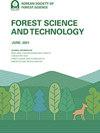Effects of elevated atmospheric CO2 on rhizosphere microbial community of Pinus densiflora (Korean red pine)
IF 2.2
Q2 FORESTRY
引用次数: 2
Abstract
Abstract The concentration of atmospheric CO2 is increasing largely owing to human activities. Although it is well established that elevated CO2 (eCO2) stimulates plant growth and primary productivity, the effect of eCO2 on soil microbial communities remains poorly understood. In this study, we aimed to examine the effects of eCO2 on the taxonomical diversity, composition, and structure of rhizosphere microbial communities of Korean red pine (Pinus densiflora) through next-generation sequencing (NGS) of 16S rRNA genes. Three bacterial phyla, Proteobacteria, Acidobacteria, and Actinobacteria, were found to be dominant in all samples. Species richness estimates (Chao1 and ACE) and diversity indices (Shannon and Simpson) for the three sampling chambers were the highest from the eCO2 (approximately 1.4× ambient, ≈ 560 ppm). These findings suggested that elevated atmospheric CO2 affected the bacterial community composition in the rhizosphere of Korean red pine (Pinus densiflora).大气CO2浓度升高对密松根际微生物群落的影响
大气CO2浓度的增加主要是由于人类活动。虽然已经确定二氧化碳(eCO2)升高可以促进植物生长和初级生产力,但eCO2对土壤微生物群落的影响仍然知之甚少。本研究旨在通过16S rRNA基因的新一代测序(NGS)研究eCO2对红松(Pinus densiflora)根际微生物群落多样性、组成和结构的影响。在所有样品中,Proteobacteria、Acidobacteria和放线菌门(Actinobacteria)为优势菌门。3个采样室的物种丰富度估算值(Chao1和ACE)和多样性指数(Shannon和Simpson)均高于eCO2(约1.4×环境,≈560 ppm)。上述结果表明,大气CO2浓度升高影响了红松根际细菌群落组成。
本文章由计算机程序翻译,如有差异,请以英文原文为准。
求助全文
约1分钟内获得全文
求助全文

 求助内容:
求助内容: 应助结果提醒方式:
应助结果提醒方式:


